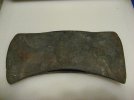Dunner
Registered User
- Joined
- Jul 24, 2004
- Messages
- 1,425
Ok, so I got doubly lucky. I headed down to Texas to help an old buddy of mine grow his business and get to learn some finish carpentry from him while I am here for a couple months. While I was streamlining his shop I found a True Temper "Perfect" Kelly Works double bit head. He told me it was all mine and now I am looking to make a haft in a 3,500 sq ft carpentry shop (my excuses for poor results are going to be running thin). I will still be doing all of the finish work on the haft with hand tools but I should be able to find a nice piece of wood and get it cut down to size in a hurry.
I want to keep this axe as compact as possible but I know there are big balance and effectiveness trade offs to making the haft shorter. How short can I make this haft before the balance starts feeling like a sledge hammer? I want to get a Council Tool Velvicut Hudson Bay axe because of its size but I don't think I can go 20" on this(?).
I am also hoping some of you may have one of these and I would love to see pics. Here is what I am working with...

I want to keep this axe as compact as possible but I know there are big balance and effectiveness trade offs to making the haft shorter. How short can I make this haft before the balance starts feeling like a sledge hammer? I want to get a Council Tool Velvicut Hudson Bay axe because of its size but I don't think I can go 20" on this(?).
I am also hoping some of you may have one of these and I would love to see pics. Here is what I am working with...

Last edited:




